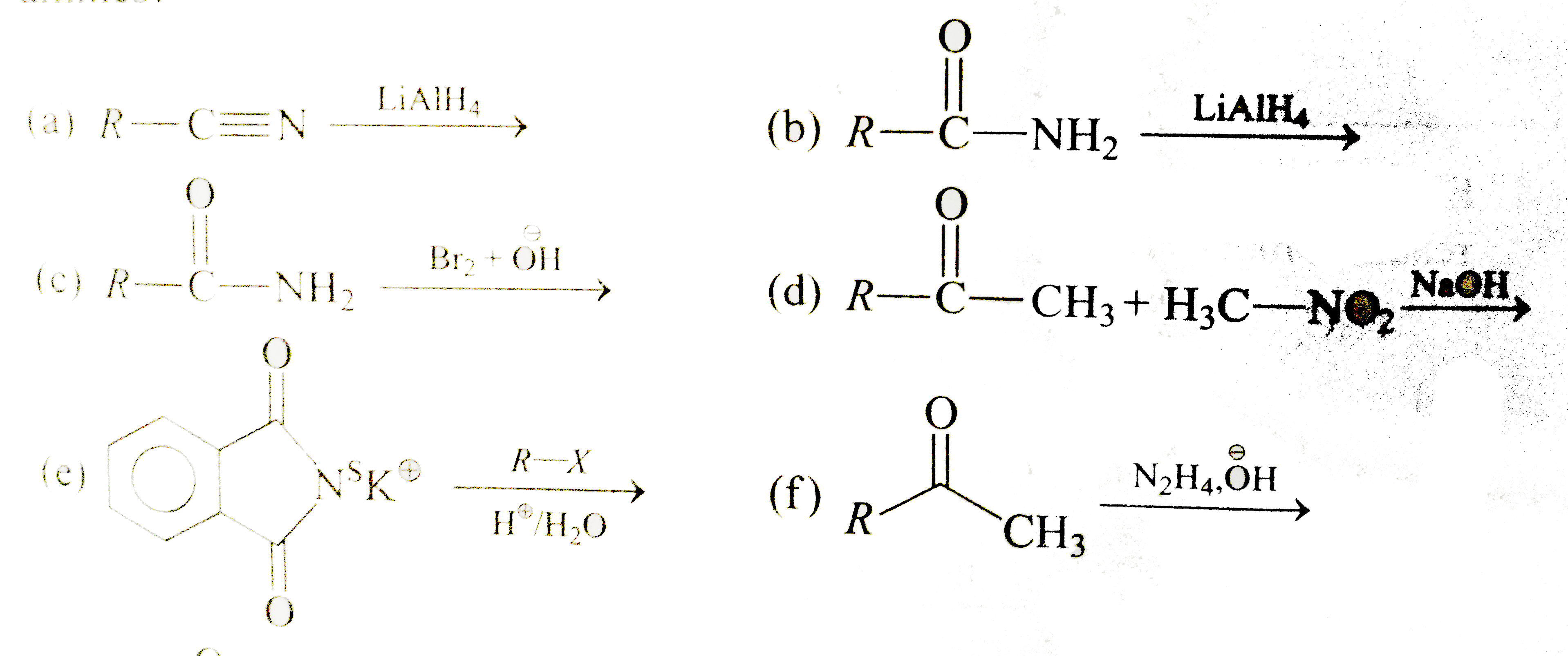Ph−O∣∣C−NH2POCl3−−−→(A), Product (A) is
Ph−NH2
Ph−CH2−NH2
Ph−OH∣CH−NH2
Ph−C≡N
The correct Answer is:D
To solve the problem, we need to determine the product (A) formed when the compound Ph−C(=O)−NH2 reacts with POCl3. Here’s a step-by-step breakdown of the reaction:
Step 1: Identify the Reactant
The reactant is Ph−C(=O)−NH2, which consists of a phenyl group (Ph), a carbonyl group (C=O), and an amine group (NH2).
Step 2: Understand the Role of POCl3
Phosphoryl chloride (POCl3) is a reagent that can facilitate the conversion of amides to nitriles. In this case, it will help in the dehydration of the amide to form a nitrile.
Step 3: Resonance Stabilization
The lone pair of electrons on the nitrogen atom (NH2) can participate in resonance with the carbonyl group. This resonance will stabilize the molecule and prepare it for the next step.
Step 4: Formation of the Intermediate
Upon treatment with POCl3, the nitrogen's lone pair can attack the carbonyl carbon, leading to the formation of an intermediate. This intermediate will have a positive charge on the nitrogen due to the donation of its lone pair.
Step 5: Elimination of Chloride Ion
The resonance structure allows for the elimination of a chloride ion (Cl-) from the intermediate. This occurs as the carbonyl group transforms into a good leaving group.
Step 6: Formation of the Nitrile
After the chloride ion leaves, the nitrogen atom will lose a hydrogen atom (H) and form a triple bond with the carbon atom. This results in the formation of a nitrile.
Step 7: Final Product
The final product (A) is Ph−C≡N, which is a phenyl nitrile. The by-products of the reaction include HCl and PO.
Conclusion
The product (A) formed from the reaction of Ph−C(=O)−NH2 with POCl3 is Ph−C≡N.
Summary of Steps:
1. Identify the reactant.
2. Understand the role of POCl3.
3. Consider resonance stabilization.
4. Form an intermediate.
5. Eliminate chloride ion.
6. Form the nitrile.
7. Conclude with the final product.
The reactant is Ph−C(=O)−NH2, which consists of a phenyl group (Ph), a carbonyl group (C=O), and an amine group (NH2).
Phosphoryl chloride (POCl3) is a reagent that can facilitate the conversion of amides to nitriles. In this case, it will help in the dehydration of the amide to form a nitrile.
The lone pair of electrons on the nitrogen atom (NH2) can participate in resonance with the carbonyl group. This resonance will stabilize the molecule and prepare it for the next step.
Upon treatment with POCl3, the nitrogen's lone pair can attack the carbonyl carbon, leading to the formation of an intermediate. This intermediate will have a positive charge on the nitrogen due to the donation of its lone pair.
The resonance structure allows for the elimination of a chloride ion (Cl-) from the intermediate. This occurs as the carbonyl group transforms into a good leaving group.
After the chloride ion leaves, the nitrogen atom will lose a hydrogen atom (H) and form a triple bond with the carbon atom. This results in the formation of a nitrile.
The final product (A) is Ph−C≡N, which is a phenyl nitrile. The by-products of the reaction include HCl and PO.
The product (A) formed from the reaction of Ph−C(=O)−NH2 with POCl3 is Ph−C≡N.
1. Identify the reactant.
2. Understand the role of POCl3.
3. Consider resonance stabilization.
4. Form an intermediate.
5. Eliminate chloride ion.
6. Form the nitrile.
7. Conclude with the final product.
Topper's Solved these Questions
Similar Questions
Of the following reactions, how many reaction, are used for the preparation of amines?
(a) R−C≡NLiAIh4−−−→ (b) R−O∣∣C−NH2LiAIH4−−−−→
(c) R−O∣C−NH2Br2+ΘOH−−−−−→ (d) R−O∣∣C−CH3+H3C−NO2NaOH−−−→

(g) R−O∣∣C−NH2P2O5−−→D (h) R−CH2−NO2H2,Ni−−−→
View SolutionPh−O∣∣C−OHSOCl2−−−→(A)H2−−−−−−−−→Pd−BaSO4(B)
Product (B) is:
View Solution
Knowledge Check
Ph−O∣∣C−CH3PCI5−−→ Product is
APh−CI∣C∣CI−CH3BPh−CH∣CI−CH2∣CIC DPh—CH2—CH2—Cl
DPh—CH2—CH2—ClPh−O∣∣C−NH2POCl3−−−→(A)
उत्पाद (A) है:APh−NH2BPh−CH2−NH2CPh−OH∣CH−NH2DPh−C=NPh−C∣∣O−NH2POCl3−−−→ products is
ABenzonitrileBBenzamineCChloro benzeneDAniline
CH3−O∣∣C−CH3+H−O∣∣C−H KOH−−→
(A) major. Product (A) is :
View SolutionWhich of the major product of the following reaction?
CH3−O∣∣C−CIH2S−−→ product
View SolutionCh3−O∣∣C−O∣∣C−PhCH3CO3H−−−−−−→ product, Product will be :
View SolutionR−O∣∣C−NH2NaNO2−−−−→HClA A is :
View SolutionEt−O−O∣∣C−CH2−CH2−O∣∣C−O−EtEtONa−−−→
Major product of this reaction is :
View Solution